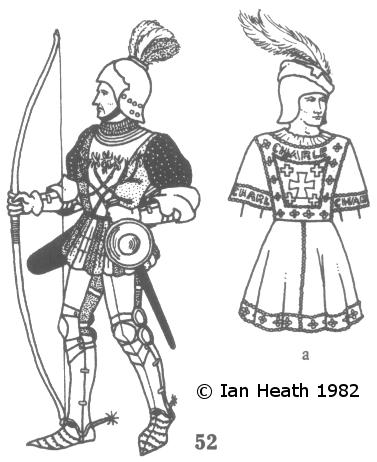
Amazon Audible Gift Memberships
SCOTTISH ARCHER, CHARLES VII’s GUARD c.1455
An extract from Armies of the Middle Ages, Volume 1by Ian Heath


52. SCOTTISH ARCHER, CHARLES VII’s GUARD c.1455
Mathieu d’Escouchy described the Scottish archers of the Guard in 1449 as ‘archers and crossbowmen of the king’s bodyguard to the number of 5or 6 score, who were more sumptuously equipped than the rest, and had haquetons (aketons) without sleeves, of red, white and green, all charged with gold, having plumes on their sallets of the same colours, and their swords and leg-armour were richly adorned in silver.’ The accuracy of this description is borne out by the figure depicted here, which comes from a miniature attributed to Jean Fouquet and painted between 1452 and 1461 in which 17 such guardsmen are visible. The body of the jacket is red on the right and green on the left with a white central panel and a vertically striped green/white/red skirt, the entirety being embroidered with a pattern of white-spotted black or dark brown stalks and white flowers (rose-stalks being Charles VII’s badge and red, white and green his livery colours). The plumes are green/white/red, the puffed sleeves black with white decoration, the belt and scabbard are also black, gloves are white and the quiver is red. His hose, visible on the backs of his thighs (only the fronts and sides being armoured), are also red. Another miniature of 1458-59 by the same artist shows guardsmen attending at court who have long, vertically-striped sleeves in place of the short puffed ones described here.
Descriptions of the uniforms worn by Louis XI’s and Charles VIII’s Guards indicate that they were dressed very similarly. In 1463 Louis’ guardsmen wore the same red, green and white jacket ‘without sleeves’ (this appears to have actually meant ‘short-sleeved’) but with a silver crown front and back, and the helmet crest, made up of 12 feathers, was in the same colours. Their captain William Stayer and the 25 senior guardsmen differed slightly in that on their jackets they wore the crown in gold along with the royal emblem of St Michael conquering the devil, in addition Stayer’s helmet crest was ‘adorned with gold braid and pendant ornaments in gold and silver’.
A description of Charles VIII’s Guards in 1487 bears an even closer resemblance to Fouquet’s painting. Their captain wore a jacket of crimson damask in front and buckram behind, with a crown on breast and back encircled by wreaths of roses and rose branches, the whole being decorated in gold and silver. The crest on his helmet was made up of 18 feathers in red, green and white, again adorned with gold braid and pendants. His men wore the usual jackets ‘without sleeves’, striped in crimson, green and white with embroidered white and yellow collars.
One other surviving piece of information on uniforms is provided by an early-17th century engraving of a lost 15th century tapestry depicting Charles VII’s entry into Orleans in 1429, in which a number of guardsmen are shown. 52a shows the uniform of one such figure, which bears no resemblance whatsoever to the foregoing descriptions. Colours are unknown, but the crosses were probably white on a red field. A variety of styles of the plumed cap are shown in the original, worn on their own or over helmets or quilted coifs.
Moving on to the guardsmen’s arms, the bow was of course their principal weapon, though they also included some crossbowmen until 1455. Fouquet’s picture, however, shows at least 6 of the guardsmen, including their captain, with glaives, at least 2 such glaive-armed guardsmen also substituting 18" deep oval shields in place of the buckler carried here. Probably either weapon might be used according to circumstances; when on duty in court, for example, the glaive was certainly carried. The larger shields were tan with an iron boss and the same floral pattern as was worn on the jacket.
Note the spurs, the guardsmen being mounted infantry, in which role they were to distinguish themselves in the war between Louis XI and Charles the Bold in 1470-72.